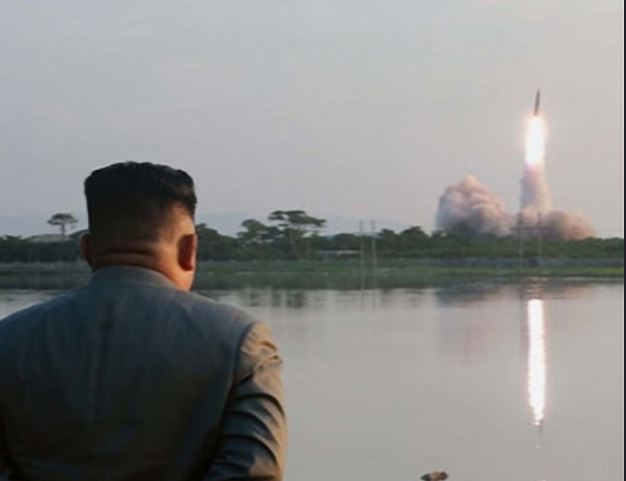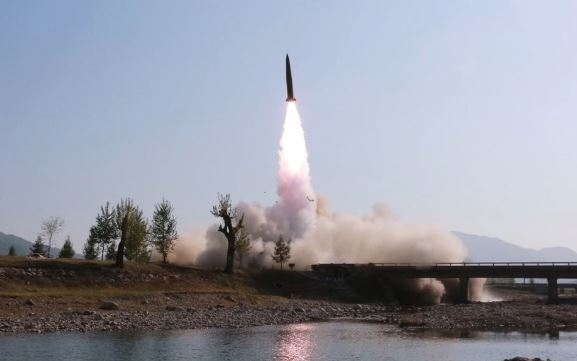N. Korea's 'new' ballistic missiles similar to Russia's Iskander: Seoul
By YonhapPublished : July 26, 2019 - 11:26
The short-range missiles that North Korea test-fired this week were a new type of ballistic weapon similar to Russia's Iskander, the military authorities here said Friday, citing the projectiles' unique flight pattern.

North Korea on Thursday fired two short-range missiles into the East Sea from near the eastern coastal town of Wonsan, and both flew around 600 kilometers at an altitude of around 50 km, according to an officer at the Joint Chiefs of Staff.
"Differing from a general parabolic trajectory, the Iskander shows a complicated flight pattern and what North Korea fired yesterday showed a similar one," the officer noted.
It is the first time that the military authorities have officially offered such an assessment, though experts have said North Korea has tested its version of the Iskander, a ground-to-ground short-range ballistic missile, since May.

The two missiles were initially presumed to have flown 430 km and 690 km, respectively, but "further analysis conducted jointly with the United States showed that the missiles added the so-called pull-up maneuver in the dive phase," the officer said.
In the reentry phase, the Iskander pulls up to fly horizontally and then dives to attack its target with a near 90-degree falling angle, which aims to avoid interception, according to experts.
This analysis is in line with a report by the North's Korean Central News Agency on Friday, which said that its new tactical guided weapon system has the specific features of a "low-altitude gliding and leaping flight orbit."
The KCNA also said that the launches gave "satisfactory verification once again to the efficiency" of the weapons system, suggesting the missile's development has neared completion for field deployment.
In fact, the South Korean radar system reportedly failed to detect their terminal-phase moves Thursday.
"Such a gray area is due to the curvature of the Earth, and North Korea's firing of the missiles northeastward from its east coastal region made the zone wider," the officer said, adding that if the weapon is fired southward, South Korean assets can detect it.
The JCS officer said that the military authorities see it as very likely that this new type of missile is similar to those fired in May, adding that those launches "appear aimed at testing the new weapon."
On May 4, the North launched a fusillade of projectiles involving "a new type of tactical guided weapon" and 240-millimeter and 300-mm multiple rocket launcher systems. The projectiles flew about 70 km to 200 km, according to the JCS.
Five days later, it fired a further barrage of projectiles, including two short-range missiles that flew 270 km and 420 km.
Pyongyang showed off its version of the Iskander for the first time during a military parade in February 2018, but did not test-fire it until May.
"Since its first launch in May, North Korea is believed to have improved the capabilities of the new weapon," a military source said, requesting anonymity.
Asked if South Korea's defense ministry sees the latest firing as a violation of last year's inter-Korean military deal under which the two Koreas agreed to halt all hostile acts against each other, a ministry official said it does not ban the test-firing of ballistic missiles.
But UN Security Council resolutions ban Pyongyang from conducting all kinds of ballistic missile launches.
"We express strong regret over the firing, which does not help ongoing efforts for easing tensions on the Korean Peninsula," a ministry official said. Despite North Korea's warnings against Seoul's introduction of new weapons and the planned joint military exercise with the US, the official said the command post exercise will be conducted as scheduled, and South Korean moves (of the weapons development) are to better counter evolving threats from North Korea." (Yonhap)




![[Herald Interview] 'Amid aging population, Korea to invite more young professionals from overseas'](http://res.heraldm.com/phpwas/restmb_idxmake.php?idx=644&simg=/content/image/2024/04/24/20240424050844_0.jpg&u=20240424200058)












![[KH Explains] Korean shipbuilding stocks rally: Real growth or bubble?](http://res.heraldm.com/phpwas/restmb_idxmake.php?idx=652&simg=/content/image/2024/04/25/20240425050656_0.jpg&u=)

